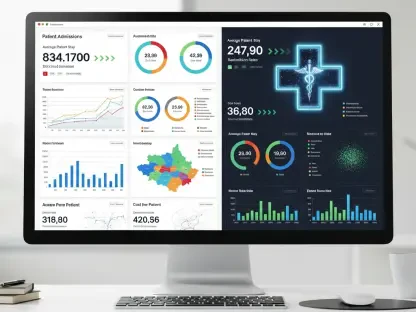Healthcare has long stood as a prime target for cyber-attacks because the value of patient data remains extraordinarily high, making a robust cybersecurity strategy essential. Yet, the complexity of digital transformation, combined with stringent regulatory requirements, presents significant challenges. Recently, evolving cyber threats have compelled healthcare organizations to adopt transformative cybersecurity measures to safeguard sensitive health information. Understanding and adapting to these changes are vital as organizations grapple with outdated systems and limited budgets. This article delves into the rapidly changing cybersecurity landscape within healthcare, focusing on proposed regulations and the strategic measures needed to secure data.
Evolving Threat Landscape
Increased Cyber Threats and Healthcare Vulnerabilities
Cyber threats against healthcare organizations have surged, driven by the intrinsic value of sensitive patient data that often fetches a high price on the black market. Hackers, recognizing the lucrative nature of medical records—and the often outdated security systems protecting them—have increasingly targeted this sector. Many healthcare institutions operate on legacy systems lacking advanced security enhancements, rendering them especially prone to data breaches and cyber-attacks. Inadequate security budgets further exacerbate vulnerabilities, creating a ripe environment for cybercriminals to exploit. This evolving threat landscape requires healthcare organizations to reassess and strengthen their cybersecurity measures.
Moreover, the interconnectedness of the healthcare network, from hospital systems to wearable health technologies, expands the points of vulnerability. Each connected device represents a potential entryway for cyber threats, elevating the demand for stringent security protocols. The rapid adoption of digital health solutions has not always been met with proportional attention to cybersecurity, further complicating the situation. The urgency is now upon healthcare leaders to invest in scalable, adaptive cybersecurity solutions that span their entire digital ecosystem. This comprehensive approach is essential to protect both patient data and institutional integrity.
The Impact of Data Breaches on Healthcare
Data breaches in healthcare carry profound consequences that go beyond financial losses. The exposure of sensitive patient information can lead to a significant loss of trust, damage to reputation, and hefty regulatory penalties. Such breaches can disrupt hospital operations, delay patient care, and leave organizations grappling with the aftermath long after the incident. Recent breaches have highlighted the precarious nature of healthcare data security, with attacks causing financial turmoil and eroding patient confidence. The long-term repercussions underscore the necessity for proactive cybersecurity measures to mitigate these risks and safeguard public trust.
In analyzing recent breaches, it becomes evident how vulnerable existing security infrastructures are and how swiftly attackers can exploit them. Breaches often result in multi-million-dollar fines, along with legal and regulatory scrutiny, further compounding the financial burden on affected organizations. The consequent fallout isn’t merely monetary; it ultimately undermines patient trust in the healthcare providers’ ability to protect their most sensitive information. Anticipating the impact of these breaches, healthcare centers are now tasked with fortifying their defenses to preclude future occurrences and preserve their standing as trusted entities in patient care.
Regulatory Changes and Implications
HIPAA Security Rule Amendments
The proposed amendments to the HIPAA Security Rule represent a critical shift in how healthcare organizations must approach cybersecurity. Emphasizing network segmentation and real-time monitoring, these changes aim to curb vulnerabilities associated with sprawling network environments. By dividing IT environments into smaller segments, organizations can protect sensitive systems and minimize the potential impact of breaches. Real-time monitoring allows healthcare providers to swiftly detect and respond to threats, ensuring robust defenses against increasingly sophisticated cyber-attacks. This shift necessitates a reevaluation of existing security policies and the adoption of innovative technologies tailored to safeguard patient data.
While the foundational principles of these amendments may seem familiar, their implementation presents new challenges for healthcare systems, particularly in hybrid networks that encompass on-premises and cloud infrastructures. Ensuring compliance with the amended HIPAA guidelines requires healthcare institutions to achieve full visibility into their data flows and maintain granular access controls. These measures are crucial to detecting anomalies and preventing unauthorized data access. As the regulatory landscape becomes increasingly complex, it is imperative for healthcare organizations to adapt quickly, creating resilient security frameworks that align with new expectations.
Integration with Other Data Protection Standards
Aligning HIPAA compliance with other global data protection mandates like GDPR and CCPA is essential in the current regulatory environment. This alignment ensures a unified strategy for managing multiple requirements while maintaining robust protection. The interconnected nature of these regulations imposes a significant responsibility on healthcare providers to streamline their compliance initiatives, thus avoiding costly breaches and ensuring best practices are followed across the board. This proactive approach is fundamental to ensuring comprehensive data security and demonstrating a commitment to patient privacy and data protection across various jurisdictions.
In a globalized world, safeguarding data privacy across borders requires an integrated compliance strategy that aligns the various standards and regulations in the industry. This harmonization helps prevent costly regulatory setbacks while enhancing patient trust in healthcare systems. By employing coherent frameworks, healthcare organizations can efficiently manage compliance tasks, from audits to reporting, reducing redundancy and enhancing their cybersecurity posture. Ultimately, creating a synergistic approach to compliance facilitates improved data protection, enabling healthcare entities to better navigate the evolving regulatory landscape and protect patient health data more comprehensively.
Strategies for Cyber Resilience
Implementing Network Segmentation
Network segmentation stands as a foundational cybersecurity strategy within healthcare, serving to isolate sensitive systems and reduce the damage of potential breaches. By dividing network environments into discrete segments, institutions can limit lateral threat movement, confining any breach to a specific area rather than allowing it to spread uncontrollably. This containment strategy minimizes the exploitation of vulnerabilities, preserving the integrity of other network areas. Implementing effective segmentation requires a sophisticated approach that can integrate seamlessly within the complex IT environments of healthcare organizations, ensuring protection across all levels.
Segmentation requires healthcare organizations to dissect their IT environments into smaller, isolated units, thus reducing the risk of cyber threats impacting broad sections of the network. By fortifying each segment with specific security measures, organizations can effectively localize any attempted breach, mitigating damage and expediting recovery processes. This approach demands careful planning and precise execution, supporting the intricate network configurations present in modern healthcare systems. In doing so, healthcare providers can achieve a significant enhancement in data protection, safeguarding the confidentiality and integrity of patient information.
Real-Time Monitoring and Automation
In the face of rapidly evolving cyber threats, real-time monitoring and automation become indispensable for detecting and responding to potential security incidents. Continuous surveillance enables organizations to quickly identify anomalies and vulnerabilities, mitigating risks before they escalate into significant breaches. Automation streamlines response efforts, utilizing advanced technologies such as machine learning and AI to manage cybersecurity threats effectively. These intelligent systems enhance surveillance capabilities by autonomously analyzing network traffic patterns and executing defensive actions against suspicious activities, ensuring a proactive security posture.
Machine learning and AI technologies have emerged as critical tools in modern cybersecurity strategies, allowing healthcare providers to strengthen threat management capabilities. These technologies can uncover hidden vulnerabilities, predict imminent threats, and automate response protocols, significantly enhancing an organization’s ability to defend against cyber-attacks. Efficiently responding to anomalies reduces the risk of substantial data loss and operational disruptions, ensuring continuity in delivering patient care. Thus, integrating real-time monitoring and automated systems forms a robust foundation for securing healthcare information systems against diverse cyber threats.
Building a Cybersecurity Culture
Promoting Cybersecurity Awareness and Training
Promoting a culture of cybersecurity awareness through comprehensive training programs is vital for maintaining security within healthcare organizations. Educating personnel about potential threats and their role in preventing breaches enhances an institution’s overall security posture. Training should encompass various aspects of cybersecurity, from recognizing phishing attempts to understanding data protection protocols. Ensuring that all employees are well-versed in security best practices instills a sense of responsibility and vigilance, helping to mitigate human error, which often serves as a gateway for cyber threats.
Awareness initiatives provide healthcare employees at all organizational levels with the skills necessary to recognize and respond to cybersecurity challenges effectively. Customized training programs can address specific roles, ensuring that everyone from frontline staff to IT professionals understands the critical importance of safeguarding patient data. By cultivating a pervasive security mindset, healthcare organizations can substantially decrease the likelihood of successful cyber-attacks, fostering trust in their ability to protect patient information.
Investing in Scalable Solutions
The healthcare sector, with its valuable troves of patient data, has consistently been a prominent target for cyber-attacks, underscoring the need for a robust cybersecurity framework. The pursuit of digital transformation, compounded by strict regulatory compliance, introduces substantial hurdles for these organizations. Recently, the emergence of sophisticated cyber threats has pressured healthcare entities to embrace transformative cybersecurity strategies to protect confidential health data effectively. Navigating these changes is crucial as organizations confront obsolete systems and tightened budgets. This exploration offers insight into the swiftly evolving cybersecurity terrain in healthcare, emphasizing upcoming regulations and strategic approaches essential for data security. Addressing these challenges is crucial to ensuring the protection of patient information, as well as maintaining trust and integrity in healthcare systems amidst ongoing digital advancements and heightened scrutiny from cyber attackers.









